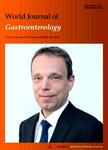Several factors including ITPA polymorphism influence ribavirin-induced anemia in chronic hepatitis C
Several factors including ITPA polymorphism influence ribavirin-induced anemia in chronic hepatitis C作者机构:Institute of Clinical Medicine and ResearchThe Jikei University School of Medicine163-1 Kashiwa-shitaKashiwaChiba 277-8567Japan Division of Gastroenterology and HepatologyKashiwa HospitalThe Jikei University School of Medicine163-1 Kashiwa-shitaKashiwaChiba 277-8567Japan Department of GastroenterologyShinmatsudo Central General Hospital1-380 ShinmatsudoMatsudoChiba 270-0034Japan Division of Gastroenterology and HepatologyKatsushika Medical CenterThe Jikei University School of Medicine6-41-2 AotoKatsushika-kuTokyo 125-8506Japan
出 版 物:《World Journal of Gastroenterology》 (世界胃肠病学杂志(英文版))
年 卷 期:2012年第18卷第41期
页 面:5879-5888页
核心收录:
学科分类:1004[医学-公共卫生与预防医学(可授医学、理学学位)] 100401[医学-流行病与卫生统计学] 10[医学]
基 金:Supported by Clinical Research Funds from Division of Gastroenterology and Hepatology Katsushika Medical Center The Jikei University School of Medicine
主 题:Chronic hepatitis C virus infection Ribavi-rin Pegylated interferon Prediction model Hemolyticanemia Single nucleotide polymorphism
摘 要:AIM: To construct formulae for predicting the likelihood of ribavirin-induced anemia in pegylated interferon plus ribavirin for chronic hepatitis C. METHODS: Five hundred and sixty-one Japanese patients with hepatitis C virus genotype lb who had received combination treatment were enrolled and as- signed randomly to the derivation and confirmatory groups. Single nucleotide polymorphisms at or nearby ITPA were genotyped by real-time detection poly- merase chain reaction. Factors influencing significant anemia (hemoglobin concentration 〈 10.0 g/dL at week 4 of treatment) and significant hemoglobin decline (declining concentrations 〉 3.0 g/dL at week 4) were analyzed using multiple regression analyses. Prediction formulae were constructed by significantly independent factors. RESULTS: Multivariate analysis for the derivation group identified four independent factors associated with significant hemoglobin decline: hemoglobin decline at week 2 [P = 3.29× 10^4, odds ratio (OR) = 7.54 (g/dL)], estimated glomerular filtration rate [P = 2.16× 10^4, OR = 0.962 (ml/min/1.73 m2)], rs1127354 (P = 5.75 × 10^4, OR = 10.94) and baseline hemoglobin [P = 7.86 × 10^4, OR = 1.50 (g/alL)]. Using the model constructed by these factors, positive and negative predictive values and predictive accuracy were 79.8%, 88.8% and 86.2%, respectively. For the confirmatory group, they were 83.3%, 91.0% and 88.3%. These factors were closely correlated with significant anemia. However, the model could not be constructed, because no patients with rs1127354 minor genotype CA/AA had significant anemia. CONCLUSION: Reliable formulae for predicting the likelihood of ribavirin-induced anemia were constructed. Such modeling may be useful in developing individual tailoring and optimization of ribavirin dosage.



